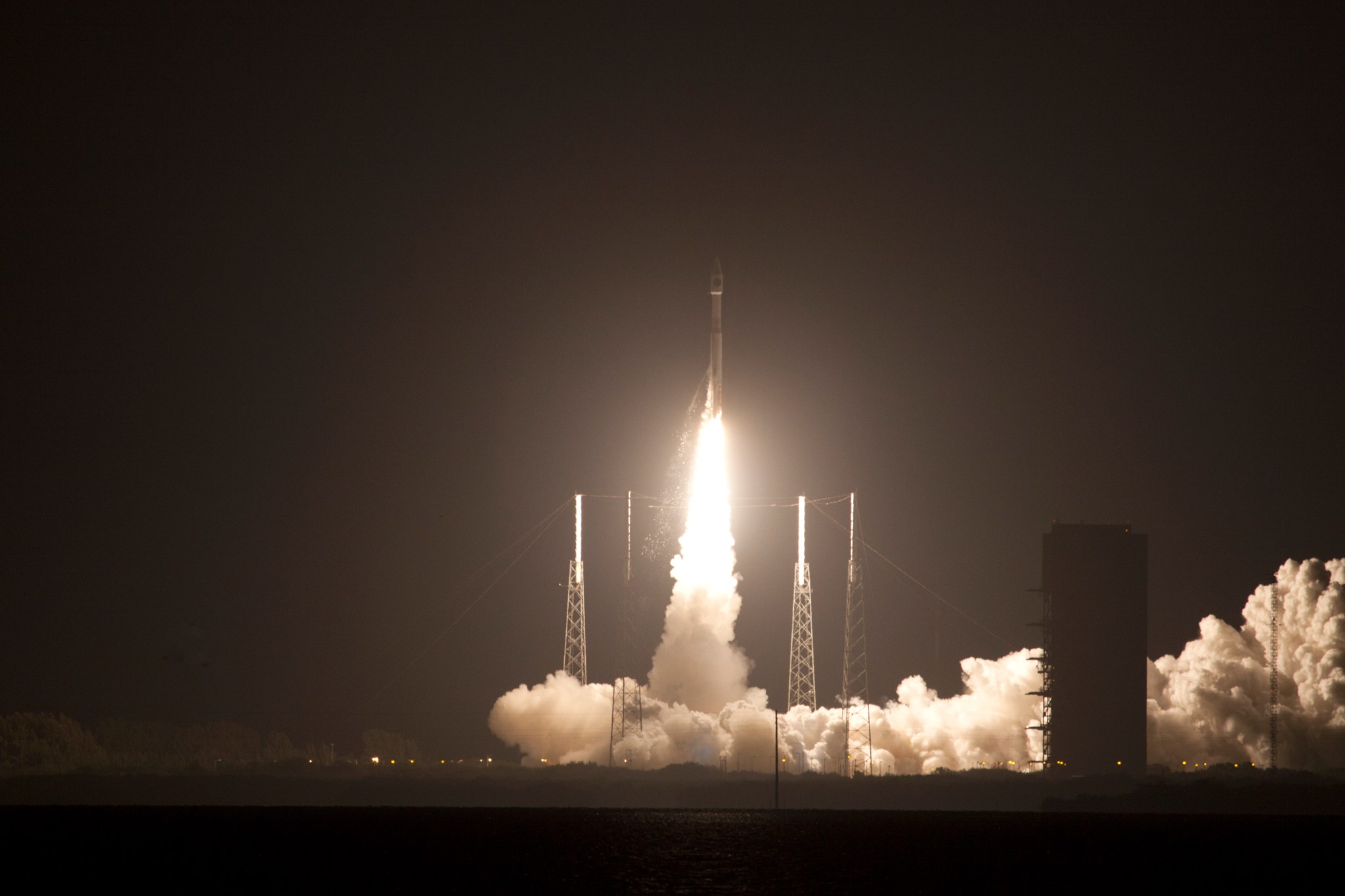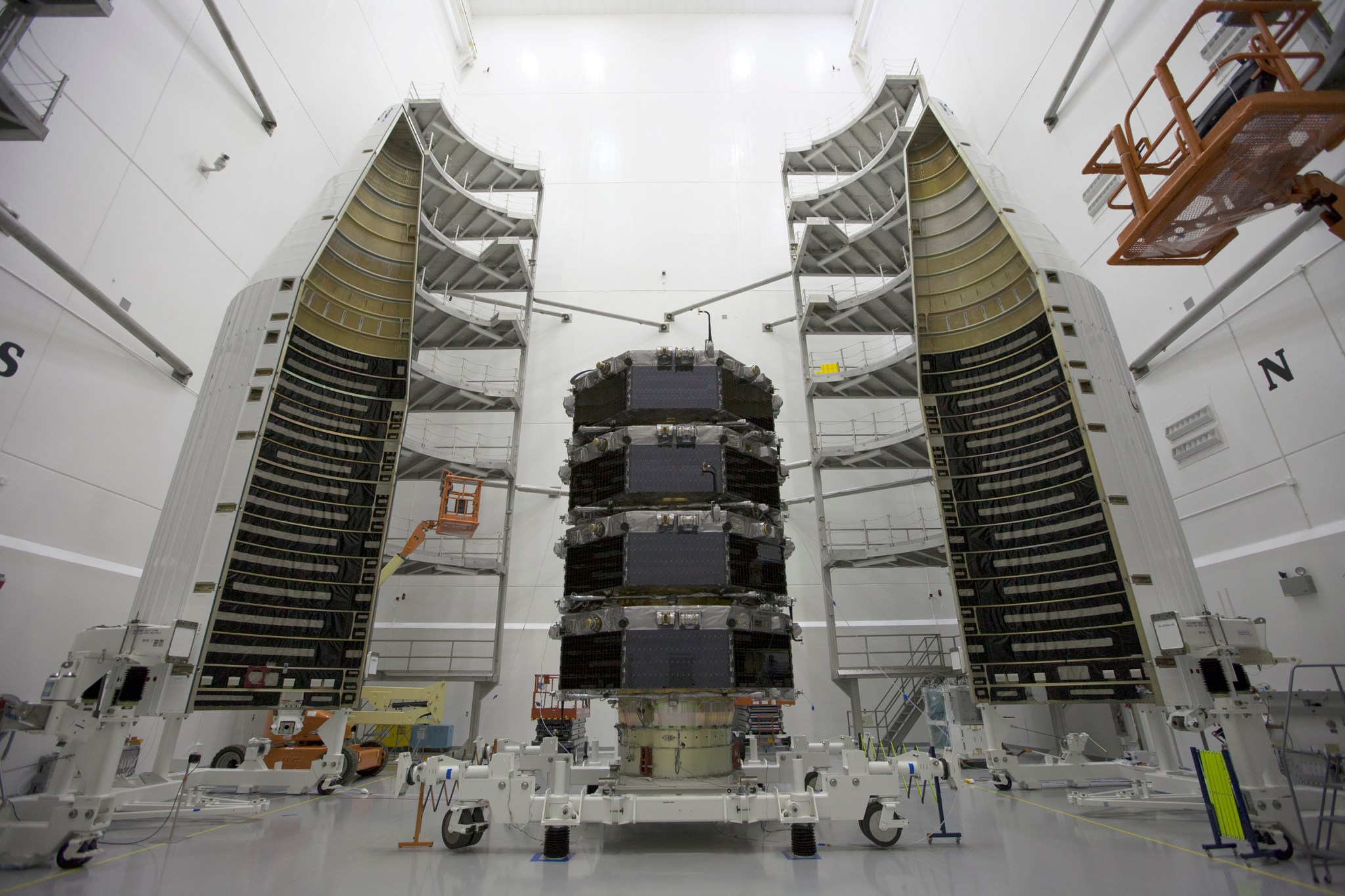Four octagonal disc-shaped spacecraft are flying in a loose formation above Earth following a brilliant, thundering launch from Florida that lit up the Cape Canaveral region for miles late Thursday night. The spacecraft make up the Magnetospheric MultiScale mission which is set to decipher interactions within magnetic fields that cause tremendous amounts of energy to be released when the fields reconnect.
A United Launch Alliance Atlas V lifted the four spacecraft into orbit with the help of solid-fueled boosters that joined with the RD-180 main engine on the first stage to produce 1.5 million pounds of thrust at liftoff. The four spacecraft deployed separately beginning about an hour-and-a-half after the 10:44 p.m. EDT liftoff. It took about 15 minutes to deploy all four, each flying free five minutes after the previous one.
“It was a picture-perfect launch and the flight went well and everyone’s cheering,” said Omar Baez, NASA launch director for MMS. “You can’t ask for anything more. This was a really hard mission to put together and the team really made it look easy, but it’s not.”
The four spacecraft will fly in a pyramid formation through space to take unprecedented measurements of magnetic reconnection phenomenon as it occurs in different areas of Earth’s magnetosphere. The spacecraft will fly the first phase of the mission in an elliptical orbit of 1,600 miles above Earth to reach out more than 43,000 miles from the planet. After a year-and-a-half in that orbit, the MMS formation will take its orbit out to 95,000 miles, almost halfway to the moon.
“This evening unfolded essentially perfectly for us,” said Craig Tooley, program manager for MMS. “As we separated them in turn, we talked to them and they are all healthy and we’re headed into our mission.”
Researchers theorize that the principles of magnetic reconnection and the energy release they generate are a significant force throughout the universe including the acceleration of ultra-high-energy cosmic rays. Reconnection is also thought to be a factor in solar flares and other conditions of space weather that can disrupt satellite electronics above Earth and some devices on the planet.
“Everything to do with space weather starts with reconnection,” said Jim Burch, principal investigator for MMS from Southwest Research Institute. “The MMS mission will conduct a definitive experiment in space that will finally allow us to understand how magnetic reconnection works. A fundamental question is why and how does magnetic reconnection take place. With MMS we will be able to study the region where those reconnections take place. MMS is the only way we can solve this mystery and we look forward to doing it.”
Scientists also think that a better understanding of magnetic reconnection can lead to a better and cleaner energy production on Earth since fusion reactors are limited by the way magnetic fields behave.
Each MMS observatory is equipped with 25 sensors and can record magnetic interactions more than 100 times faster than any previous mission. The observatories were built at NASA’s Goddard Space Flight Center in Greenbelt, Maryland. Each weighs about 3,000 pounds fully fueled and measures 11 feet in diameter by 4 feet high. Once flying on their own, each spacecraft will deploy a set of booms that are carrying some of the instruments expected to measure the magnetic conditions. They will fly in the portion of space where the sun’s magnetic field connects with Earth’s and later in the night-side portion of Earth’s magnetic field where reconnection is thought to trigger the auroras known as the northern and southern lights.
The shortest of the instrumented booms are about 15 feet long, while the wire booms reach out some 200 feet from each side of the spacecraft to detect the magnetic fields.
“Each of these spacecraft will have a footprint about the size of a football field,” Tooley said. Their formation will change dimensions during the mission but they will generally not get any closer than 5 miles to each other. “It’s best to think of this mission as a flying laboratory, not really a remote sensing spacecraft, essentially scientists flying these spacecraft through a natural laboratory.”
The launch was the 53rd for the Atlas V and marked the completion of about six years of rocket selection, manufacturing and integration ahead of the launch preparation for the MMS and NASA’s Launch Services Program teams along with United Launch Alliance.




























